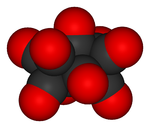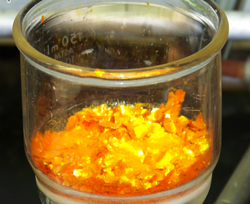- Diiron nonacarbonyl
-
Diiron nonacarbonyl 

 Diiron nonacarbonyl, tri-μ-carbonyl-bis(tricarbonyliron)(Fe—Fe)Other namesIron enneacarbonyl
Diiron nonacarbonyl, tri-μ-carbonyl-bis(tricarbonyliron)(Fe—Fe)Other namesIron enneacarbonylIdentifiers CAS number 15321-51-4 
ChemSpider 4807522 
Jmol-3D images Image 1 - [Fe].[Fe].[C-]#[O+].[O+]#[C-].[O+]#[C-].[O+]#[C-].[O+]#[C-].[O+]#[C-].[O+]#[C-].[O+]#[C-].[O+]#[C-]
Properties Molecular formula Fe2C9O9 Molar mass 363.78 g/mol Appearance orange crystals Density 2.08 g/cm3 Melting point decomposes at 100 °C
Boiling point decomposes
Solubility in water insoluble Structure Dipole moment 0 D Hazards Main hazards Toxic Related compounds Related iron carbonyls Iron pentacarbonyl
Triiron dodecacarbonylRelated compounds Dimanganese decacarbonyl
Dicobalt octacarbonyl nonacarbonyl (verify) (what is:
nonacarbonyl (verify) (what is:  /
/ ?)
?)
Except where noted otherwise, data are given for materials in their standard state (at 25 °C, 100 kPa)Infobox references Diiron nonacarbonyl is an inorganic compound with the formula Fe2(CO)9. This metal carbonyl is an important reagent in organometallic chemistry and of occasional use in organic synthesis.[1] It is a more reactive source of Fe(0) than Fe(CO)5 and less dangerous to handle because it is nonvolatile. This micaceous orange solid is virtually insoluble in all common solvents.
Synthesis and structure
Following the original method,[2] photolysis of an acetic acid solution of Fe(CO)5 produces Fe2(CO)9 in good yield:[3][4]
- 2 Fe(CO)5 → Fe2(CO)9 + CO
Fe2(CO)9 consists of a pair of Fe(CO)3 centers linked by three bridging CO ligands. The iron atoms are equivalent and octahedral molecular geometry. Elucidation of the structure of Fe2(CO)9 proved to be challenging because its low solubility inhibits growth of crystals. The Mößbauer spectrum reveals one quadrupole doublet, consistent with the D3h-symmetric structure.
Reactions
Fe2(CO)9 is a precursor to compounds of the type Fe(CO)4L and Fe(CO)3(diene). Such syntheses are typically conducted in THF solution. In these conversions, it is proposed that small amounts of Fe2(CO)9 dissolve according the following reaction:[5]
- Fe2(CO)9 → Fe(CO)5 + Fe(CO)4(THF)
Cyclobutadieneiron tricarbonyl is prepared using Fe2(CO)9. Fe2(CO)9 has also been employed in the synthesis of cyclopentadienones via a net [2+3]-cycloaddition from dibromoketones, known as the Noyori [3+2] reaction.[6]
Low temperature UV/vis photolysis of Fe2(CO)9 yields the Fe2(CO)8 unsaturated complex, producing both CO-bridged and unbridged isomers. [7]
References
- ^ Elschenbroich, C.; Salzer, A. ”Organometallics : A Concise Introduction” (2nd Ed) (1992) Wiley-VCH: Weinheim. ISBN 3-527-28165-7
- ^ Edmund Speyer, Hans Wolf "Über die Bildungsweise von Eisen-nonacarbonyl aus Eisen-pentacarbonyl" Berichte der deutschen chemischen Gesellschaft, 1924 volume 60, p. 1424-1425. doi:10.1002/cber.19270600626
- ^ King, R. B. Organometallic Syntheses. Volume 1 Transition-Metal Compounds; Academic Press: New York, 1965. ISBN 0-444-42607-8.
- ^ E. H. Braye, W. Hübel (1966). "Diiron Enneacarbonyl". Inorg. Synth.. Inorganic Syntheses 8: 178. doi:10.1002/9780470132395.ch46. ISBN 9780470132395.
- ^ F. Albert Cotton, Jan M. Troup "Reactivity of diiron nonacarbonyl in tetrahydrofuran. I. Isolation and characterization of pyridinetetracarbonyliron and pyrazinetetracarbonyliron" J. Am. Chem. Soc., 1974, volume 96, pp 3438–3443. doi:10.1021/ja00818a016
- ^ R. Noyori, R.; Yokoyama, K.; Hayakawa, Y. (1988), "Cyclopentanones from α, α'-Dibromoketones and Enamines: 2,5-Dimethyl-3-Phenyl-2-Cyclopenten-1-one", Org. Synth., http://www.orgsyn.org/orgsyn/orgsyn/prepContent.asp?prep=cv6p0520; Coll. Vol. 6: 520
- ^ Susan C. Fletcher, Martyn Poliakoff, James J. Turner (1986). "Structure and Reactions of Fe2(CO)8: An IR Spectroscopic study using 13C Photolysis with plane-polarized light, and matrix isolation". Inorg. Chem. 25 (20): 3597. doi:10.1021/ic00240a014.
Categories:- Carbonyl complexes
- Iron compounds
Wikimedia Foundation. 2010.
